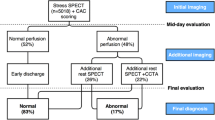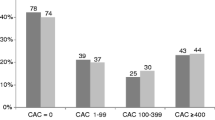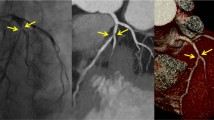Summary
Electron-beam CT (EBT) has been used for years as the gold standard to quantify coronary artery calcification as a marker of coronary atherosclerosis. With the introduction of Multi-Slice Spiral CT (MSCT) technology in 1999, EBT is now challenged in the determination of coronary calcium. The aim of this study was to determine the diagnostic accuracy of MSCT for the assessment of coronary calcium, comparing this new technique to EBT. The study population consisted of 54 male patients, aged 58±11 years with suspected coronary artery disease. For EBT, 40 axial slices (scan time=100ms, slice thickness=3mm) were acquired in one breath-hold (35±5s) using an ECG-trigger at 80% of the RR interval. For MSCT, simultaneous acquisition of four axial slices (scan time=250 ms, slice thickness=2.5mm) allowed the entire heart (40 slices) to be covered in one breath-hold (25±5 s) using a prospective ECG-trigger (R – 450ms). For quantification of coronary calcium the Agatston and the Volumetric calcium score (VCS) were applied. Mean Agatston score of the study group was calculated as 88±111 (median=45), which is between the 25th and 75th age-corrected percentile of asymptomatic patients. For the Volumetric calcium score, number of lesions, calcium mass and density, no statistical difference was found between both imaging modalities. Agatston and Volumetric calcium score were statistically different between and within both scans. Mean variability of VCS of the two methods was calculated as 24% and was in the range of repeated EBT studies (14–44.9%). The Multi-Slice Spiral CT scanner is equivalent to EBT for the determination of coronary calcium and can, therefore, be used for calcium screening. Using a prospective ECG-trigger technique, the application of the Agatston method delivers statistically different results in comparison to EBT. With the application of the spiral mode technique, retrospective ECG-trigger and thinner slice thickness, further improvement in variability can be expected, thus allowing for follow-up studies to determine progression or regression of atherosclerosis with high accuracy.
Zusammenfassung
Die Elektronenstrahltomographie gilt als Goldstandard für den Nachweis und die Quantifizierung von koronaren Kalzifizierungen (Kalkscore). Mit der Mehrschicht-Spiral-Computertomographie (MSCT) steht seit 1999 ein konventionelles CT-Verfahren mit vergleichbarer diagnostischer Bildqualität zur Verfügung. In der vorliegenden Untersuchung wurde bei 54 männlichen Patienten (Alter 58±11 Jahre) mit V.a. koronare Herzerkrankung eine Koronarkalkuntersuchung mit beiden Verfahren nach einem standardisierten Protokoll durchgeführt. Mit EBT wurden 40 axiale Schichten (Belichtungszeit=100ms, Schichtdicke=3mm) in einer Atemanhaltephase (35±5 s), EKG getriggert (80% RR-Intervall) akquiriert. Für das MSCT erfolgte die simultane Akquisition von vier axialen Schichten (Belichtungszeit=250 ms, Schichtdicke=2,5mm) in einer Atemanhaltephase (25±5 s) bei 450ms vor der R-Zacke. Der mittlere EBT-Agatstonscore aller Patienten betrug 88±111 (Median=45) und lag zwischen der 25. und 75. alters- und geschlechtskorrigierten Percentile für asymptomatische Patienten. Für den Methodenvergleich wurde der Agatston- und Volumetrische Kalziumscore, sowie die Anzahl, Masse und Dichte der kalzifizierten Läsionen bestimmt. Es zeigte sich bezüglich des Volumetrischen Kalziumscores, der Masse, Dichte sowie der Anzahl der kalzifizierten Läsionen zwischen beiden Methoden kein statistisch signifikanter Unterschied. Die mittlere Variabilität des Volumetrischen Calciumscores zwischen beiden Untersuchungen betrug 24% und lag somit im Bereich der Variabilität wiederholter Untersuchungen der EBT (14–44,9%). Das Mehrschicht-Spiral-CT ist unter Anwendung des Volumetrischen Calciumscores bei prospektiver EKG-Triggerung der EBT gleichwertig. Die Variabilität der Scorewerte beider Methoden liegt im Bereich von Wiederholungsuntersuchungen der Elektronenstrahltomographie. Der Agatstonscore liefert signifikant unterschiedliche Ergebnisse in beiden Verfahren und kann zur Befundinterpretation nicht herangezogen werden. Durch die Applikation des Spiralmodus mit retrospektivem EKG-Gating und dünneren Schichtdicken mit Overlap ist für das MSCT eine weitere Optimierung der Untersuchungsvariabilität zu erwarten, die Voraussetzung für das Follow-up von Patienten zur Bestimmung der Progression von Koronarkalk ist.
Similar content being viewed by others
Author information
Authors and Affiliations
Additional information
Eingegangen: 7. Februar 2002 Akzeptiert: 21. Mai 2002
Rights and permissions
About this article
Cite this article
Knez, A., Becker, A., Becker, C. et al. Detektion von Koronarkalk mit der Mehrschicht-Spiral-Computertomographie: Eine Alternative zur Elektronenstrahltomographie. Z Kardiol 91, 642–649 (2002). https://doi.org/10.1007/s00392-002-0838-7
Published:
Issue Date:
DOI: https://doi.org/10.1007/s00392-002-0838-7




